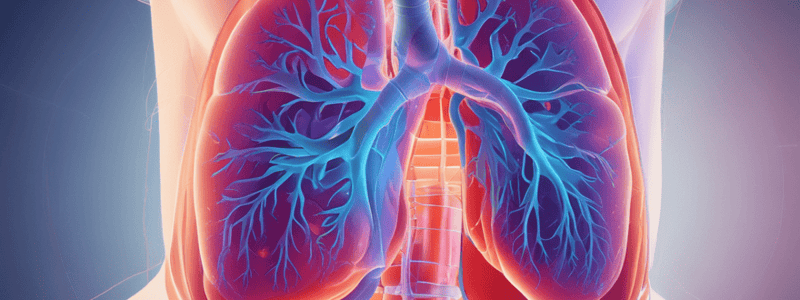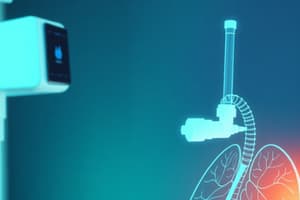Podcast
Questions and Answers
What does yellow/greenish, cloudy and thick sputum usually indicate?
What does yellow/greenish, cloudy and thick sputum usually indicate?
- Cystic fibrosis
- Bacterial infection (correct)
- Bronchiectasis
- Asthma
Which condition might be indicated by purulent and foul-smelling sputum?
Which condition might be indicated by purulent and foul-smelling sputum?
- Bronchiectasis (correct)
- Asthma
- Cystic fibrosis
- Pneumococcal pneumonia
What does hemoptysis refer to?
What does hemoptysis refer to?
- Pus-filled sputum indicating bronchiectasis
- Rusty sputum indicating blood and pneumonia
- Yellow/greenish sputum indicating a bacterial infection
- Bright red frothy sputum associated with pulmonary edema (correct)
What do wheezing sounds indicate?
What do wheezing sounds indicate?
What is the significance of orthopnea?
What is the significance of orthopnea?
What does cyanosis indicate?
What does cyanosis indicate?
What is the purpose of arterial blood gases testing?
What is the purpose of arterial blood gases testing?
'Rales' are associated with which type of sound?
'Rales' are associated with which type of sound?
'Rhonchi' are sounds resulting from:
'Rhonchi' are sounds resulting from:
Where is the cough reflex center located?
Where is the cough reflex center located?
What is the most common pathogen causing epiglottitis?
What is the most common pathogen causing epiglottitis?
Which symptom is NOT typically associated with scarlet fever?
Which symptom is NOT typically associated with scarlet fever?
What type of cough removes secretions and mucous?
What type of cough removes secretions and mucous?
'Paroxysmal nocturnal dyspnea' is common in people with:
'Paroxysmal nocturnal dyspnea' is common in people with:
What is a key sign of scarlet fever due to an exotoxin produced by Streptococcus pyogenes?
What is a key sign of scarlet fever due to an exotoxin produced by Streptococcus pyogenes?
Which diagnostic test is useful in diagnosing and monitoring COPD?
Which diagnostic test is useful in diagnosing and monitoring COPD?
Which age group is bronchiolitis (RSV Infection) most common in?
Which age group is bronchiolitis (RSV Infection) most common in?
What do oximeters measure?
What do oximeters measure?
What is a predisposing factor for bronchiolitis (RSV Infection)?
What is a predisposing factor for bronchiolitis (RSV Infection)?
Which test is used in checking for the site of a lesion or bleeding?
Which test is used in checking for the site of a lesion or bleeding?
Which infection can cause total airway obstruction due to reflex spasm?
Which infection can cause total airway obstruction due to reflex spasm?
What type of cough may benefit from cough medicine with an expectorant?
What type of cough may benefit from cough medicine with an expectorant?
When may a humidifier be helpful for a cough?
When may a humidifier be helpful for a cough?
What is the main characteristic symptom of influenza (flu)?
What is the main characteristic symptom of influenza (flu)?
What treatment is recommended for scarlet fever?
What treatment is recommended for scarlet fever?
What does exercise tolerance testing help assess in patients with COPD?
What does exercise tolerance testing help assess in patients with COPD?
Which sign is especially dangerous in premies with bronchiolitis?
Which sign is especially dangerous in premies with bronchiolitis?
What is the major mechanism of air flow limitation in emphysema?
What is the major mechanism of air flow limitation in emphysema?
Which drug is commonly used for prophylactic treatment of active TB contacts?
Which drug is commonly used for prophylactic treatment of active TB contacts?
What is the major cause of pleural abnormalities like pneumothorax?
What is the major cause of pleural abnormalities like pneumothorax?
In pneumothorax, what disrupts the negative pressure of the pleural space?
In pneumothorax, what disrupts the negative pressure of the pleural space?
Which type of pneumothorax can result in compression atelectasis?
Which type of pneumothorax can result in compression atelectasis?
What treatment is recommended for tension pneumothorax?
What treatment is recommended for tension pneumothorax?
Which condition involves both blood and air in the pleural space?
Which condition involves both blood and air in the pleural space?
Which type of pneumonia is typically caused by Streptococcus pneumoniae and localized in one or more lobes?
Which type of pneumonia is typically caused by Streptococcus pneumoniae and localized in one or more lobes?
What is a typical sign of lobar pneumonia due to the presence of RBCs in exudate?
What is a typical sign of lobar pneumonia due to the presence of RBCs in exudate?
Which type of pneumonia is common in older children and young adults, often referred to as 'walking pneumonia'?
Which type of pneumonia is common in older children and young adults, often referred to as 'walking pneumonia'?
What antibiotic is typically used to treat Mycoplasma pneumoniae infections due to its lack of a cell wall?
What antibiotic is typically used to treat Mycoplasma pneumoniae infections due to its lack of a cell wall?
Which type of pneumonia is considered opportunistic and often fatal in AIDS patients?
Which type of pneumonia is considered opportunistic and often fatal in AIDS patients?
What characteristic defines Chronic Obstructive Pulmonary Disease (COPD)?
What characteristic defines Chronic Obstructive Pulmonary Disease (COPD)?
What characteristic feature distinguishes Primary Atypical Pneumonia from other types?
What characteristic feature distinguishes Primary Atypical Pneumonia from other types?
What stage of Tuberculosis (TB) occurs when exposure to Mycobacterium tuberculosis leads to the formation of calcified tubercles?
What stage of Tuberculosis (TB) occurs when exposure to Mycobacterium tuberculosis leads to the formation of calcified tubercles?
Which statement accurately describes the progression of secondary or reinfection TB?
Which statement accurately describes the progression of secondary or reinfection TB?
Flashcards are hidden until you start studying
Study Notes
Sputum Characteristics
- Yellow/greenish, cloudy, and thick sputum indicates a bacterial infection
- Rusty or dark-colored sputum indicates blood and pneumococcal pneumonia
- Purulent (pus-filled) and foul-smelling sputum may indicate bronchiectasis
- Thick or sticky mucus is often seen in asthma or cystic fibrosis patients
- Hemoptysis is characterized by bright red, frothy sputum, associated with pulmonary edema
Breathing Patterns and Characteristics
- Normal breathing rate (eupnea) is 10-18 inspirations per minute
- Wheezing is a high-pitched whistling sound when airways are partially blocked
- Stridor is a high-pitched crowing sound indicating upper airway obstruction
- Rales are light, bubbly, or crackling sounds associated with serous secretions
- Rhonchi are deeper, harsher sounds resulting from thick mucus
- Absence of breath sounds may indicate non-aeration or collapse of a lung (atelectasis)
Dyspnea and Cyanosis
- Dyspnea is difficulty breathing, characterized by flaring nostrils, retraction of respiratory muscles, and use of accessory muscles
- Orthopnea is dyspnea when lying down, which can be helped by laying on raised pillows or a wedge
- Paroxysmal nocturnal dyspnea is sudden, acute dyspnea, common in people with left-sided heart failure
- Cyanosis is a bluish discoloration of skin and mucous membranes due to large amounts of unoxygenated hemoglobin in the blood
Pleural Pain and Friction Rub
- Pleural pain results from inflammation or infection of the parietal pleura and increases with breathing or coughing
- Friction rub is a soft sound due to rough membranes rubbing against each other, caused by inflammation in lobar pneumonia or lung infection
Infectious Diseases
Upper Respiratory Infections
- Common cold: caused by over 200 viruses, spread through respiratory droplets and fomites
- Sinusitis: bacterial infection secondary to a cold or allergy, causing nasal congestion, fever, sore throat, and facial pain
- Laryngotracheobronchitis (croup): viral infection in young children, characterized by a barking cough
- Epiglottitis: acute infection, rapid onset, fever, sore throat, and inspiratory stridor
- Influenza (flu): viral infection, sudden onset, achy, fever, headache, and fatigue
Lower Respiratory Infections
- Bronchiolitis (Respiratory Syncytial Virus Infection): inflammatory obstruction of small airways, common in young children
- Pneumonia: infection of the lungs, causing fever, chills, cough, and difficulty breathing
- Tuberculosis (TB): bacterial infection, causing cough, fever, night sweats, and weight loss
Diagnostic Tests
- Spirometry: pulmonary function testing
- Arterial blood gases: measuring oxygen, carbon dioxide, and bicarbonate levels, and serum pH
- Oximetry: measuring oxygen saturation
- Exercise tolerance testing: useful in patients with COPD for diagnosis and monitoring
- Radiography: evaluation of tumors and infections like pneumonia and TB
- Bronchoscopy: used in biopsy and checking for the site of a lesion or bleeding
- Culture and sensitivity tests: identifying pathogens in exudate from upper respiratory and sputum
Studying That Suits You
Use AI to generate personalized quizzes and flashcards to suit your learning preferences.



